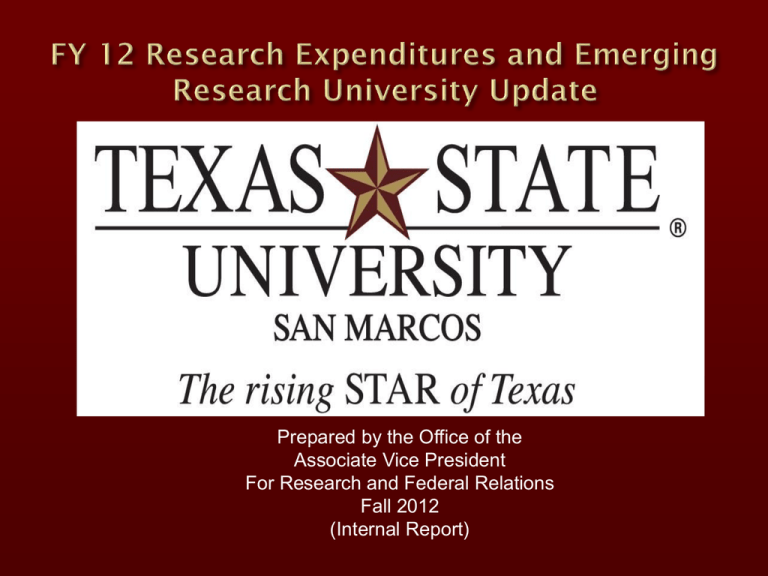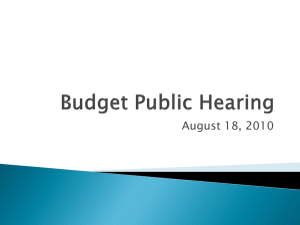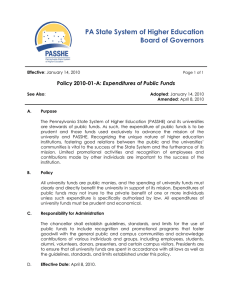FY12 Expenditure Report
advertisement

Prepared by the Office of the Associate Vice President For Research and Federal Relations Fall 2012 (Internal Report) Total Sponsored Programs Expenditures-Expenditures from awards made from external entities and support instruction, public service* and research functions. In this report, indirect costs are included. Total Sponsored Programs expenditures are not reported to the THECB. Restricted Research Expenditures-Expenditures from funds awarded by an external entity and which are restricted for support of defined research functions. May include grants, contracts or gifts from Federal, State and Private funding sources. Indirect costs are not included in THECB report. Total R&D Expenditures-The sum of expenditures from a combination of internal and external funds used to support only research functions. These expenditures reflect the entire research enterprise of the institution and are reported annually to the THECB. $32.0 M $25.8M FY08 $34.8 M $36.3M $28.0M FY09 FY10 FY11 FY12 Annual Growth: 4%; Five year growth: 40% Expenditures from all external sponsors and includes Research, Public Service, Instruction and F&A. The percentage of sponsored programs expenditures classified as Research increased 14% over FY11 and 74% during the past five years. The percentage of sponsored programs expenditures from Federal awards was essentially unchanged over FY11, but has increased by 86% over the past five years. Unit FY08 FY09 FY10 FY11 FY12 Applied Arts $9,796,799 $8,420,777 $7,796863 $7,819,466 $7,958,930 Business $596,513 $716,554 $722,883 $820,638 $1,036,386 Education $4,139,452 $3,352,670 $5,264,679 $5,469,048 $3,980,515 FAC $21,927 $44,034 $8,797 $15,702 $48,179 HP $130,268 $196,798 $1,462,902 $2,382,483 $3,068,693 Liberal Arts $1,937,082 $2,200,838 $2,242,771 $2,211,240 $1,887,372 Sci/Eng $3,760,515 $5,932,952 $6,123,251 $7,041,523 $9,400,556 U. Centers $4,060,213 $5,169,855 $7,182,873 $7,680,241 $7,634,793 VPSA $1,252,073 $1,384,647 $1,272,798 $1,340,721 $2,488,687 Fiscal Year # Unique Principal Investigators # Unique Sponsored Programs Accounts Accounts Per Principal Investigator 2012 201 570 2.83 2011 183 520 2.84 2010 175 509 2.91 2009 163 476 2.92 2008 159 461 2.89 The number of PIs has increased 26% during the past five years. The average expenditure per sponsored program per year has increased From $56K to $63K (19%) over the five year period. $21.8 M $17.8 M $11.3 M FY08 $19.0 M $13.3 M FY09 FY10 FY11 FY12 Annual growth: 14.5%; Five year growth: 93% Texas State has the highest annual and five-year increase Among Emerging Research Universities. Key parameter for National Research University Funding. Certified by THECB. Determines Research Development Fund allocations. Correlates to an institution’s potential for new discovery and impacting economic development through technology transfer and commercialization of intellectual property. Links to teaching mission since research scholars engaged in new discovery present cutting edge knowledge to students. $30.56 M $33.48 M $36.66 M $24.49 M $19.31 M FY08 FY09 FY10 FY11 FY12 Annual growth: 9.5%; Five year growth: 90% Total R&D = Restricted Research + Appropriated Funds + Institutional Funds (start up, developmental leave, RDF, REP, IDC, strategic one time, matching/cost share, departmental M&O, etc.). Incentivize and enable more individuals to engaged in funded research to increase numbers of proposals, awards and expenditures. Build infrastructure that increases research capacity while adequately meeting safety and performance standards. Design and implement program to install departmental research administrators in high activity units to increase productivity and reduce administrative burden. Optimize TRIP opportunities. To make accountability more transparent and promote excellence, The Texas Higher Education Coordinating Board took the following actions: Grouped public institutions according to general academic mission and certain key indicators such as size, number of graduate programs, research expenditures, etc. Determined for each group appropriate measures that reflect institutional performance. Established benchmarks to measure success. Assessed progress annually. Research Universities :UT-Austin, TAMU-College Station Research Universities provide a broad range of undergraduate, graduate and professional programs, place a greater emphasis on research than universities in other groups, and serve their region, the state and beyond. Excellent undergraduate education is a central function, but a significantly higher proportion of these institutions’ students will be enrolled in graduate and professional programs than the other groups (Award 100 or more doctoral degrees annually in at least 15 disciplines, $150 Million in research expenditures) Emerging Research Universities :UH, TTU, UT-Dallas, UT-El Paso, UT-San Antonio, UT-Arlington, UNT, Texas State University Emerging Research Universities are educational, scientific, engineering, business and cultural resource centers committed to the three-fold mission of teaching, research and service. As universities with extensive educational programs, academic efforts are directed to applied and basic research in selected fields, teaching and scholarship and creative activities. The universities encourage faculty members to be active researchers/creators in their respective disciplines and to involve both undergraduate and graduate students in research and creative pursuits. Offer a wide range of baccalaureate and masters degrees. Serve a student population within and outside of the region. Committed to graduate education through the doctorate degree in targeted areas of excellence Award at least 20 doctoral degrees per year. Offer at least 10 doctoral programs. Enroll a minimum of 150 doctoral students. Have restricted research expenditures in excess of $14 million dollars. 1. Enriches all students’ educational experience by providing opportunities to participate in cutting-edge research and to work with faculty mentors. 2. Immediately eligible to participate in the Texas Research Incentive Program (TRIP). TRIP was established by the Texas Legislature to provide matching funds to leverage private gifts for the enhancement of research productivity and faculty recruitment.* 50 percent of the amount made by the donor on a certain date between $100,000 but not more than $999,999. 75 percent of the amount made by the donor on a certain date between $1,000,000 but not more than $1,999,999. 100 percent of the amount made by the donor on a certain date between$2,000,000 but not more than $10,000,000. *The donor must clearly restrict the use of funds to research. W. Morgan & Lou Claire Rose Fellowship in Creative Writing 650,000.00 Endowment FA & C 325,000.00 Jane Wallace 160,000.00 Stock Transfer Science 79,735.00 PM & Jeanette Williamson Foundation 115,000.00 Grant Science 57,500.00 Kim Gunnarson 100,000.00 Endowment Liberal Arts 50,000.00 Leona Irene Spoonamore 947,216.60 Stock 473,608.00 Jerry D. & Linda Gregg Fields 100,000.00 Non-Endowed Still Water Foundation 100,000.00 Non-Endowed Multi Library Science Library Science Taylor Global, Inc. 100,000.00 Non-Endowed 50,000.00 Grant Grant Grant Grant Grant Grant Science Library Science Science Science Science Science Science 100,000.00 52,500.00 750,000.00 125,000.00 76,500.00 750,000.00 Endowment Business 149,348.00 Albert & Margaret Alkek Foundation SEMATECH Meadows Foundation Harte Research Institute Meadows Foundation Meadows Foundation Tom & Jo Roddy TOTAL SUBMITTED TOTAL MATCHED 200,000.00 105,000.00 1,000,000.00 250,000.00 153,000.00 1,000,000.00 298,696.36 50,000.00 50,000.00 5,278,912.96 3,139,191.00 NRUF-Provides funding to emerging research universities that meet critical benchmarks for achieving national research university status: Mandatory criteria ERU status $45 million in restricted research expenditures (FY13 report: 5 th out of 6 Non-NRUF eligible ERUs) Optional (4 of 6) $400 M Institutional endowments (4th out of 6) 200 Ph.D. degrees awarded annually (6th out of 6) Freshman Class of High Academic Achievement (4th out of 6) Recognition of Research Capabilities and Scholarly Attainment (Phi Kappa Phi membership attained) High Quality Faculty (7 individuals with professional distinction (4th High Quality Graduate Education (FY12: First in PhD graduation percentage and second in MS graduation percentage) ERPC was established in Fall 2012 by the Provost and charged with developing a strategic plan for research to be submitted to the THECB. The strategic plan must contain sections that address: vision statement, plan to increase research funding and productivity, plan to improve undergraduate education, plan for doctoral programs (existing and new), plan for faculty and student development, other resources, and national visibility. The committee has assessed which 4 optional requirements Texas State is most likely to achieve in an 8-10 year time frame. The committee will also identify peer and comparison institutions based on numerous institutional data elements. The plan will be submitted in Spring 2013.



